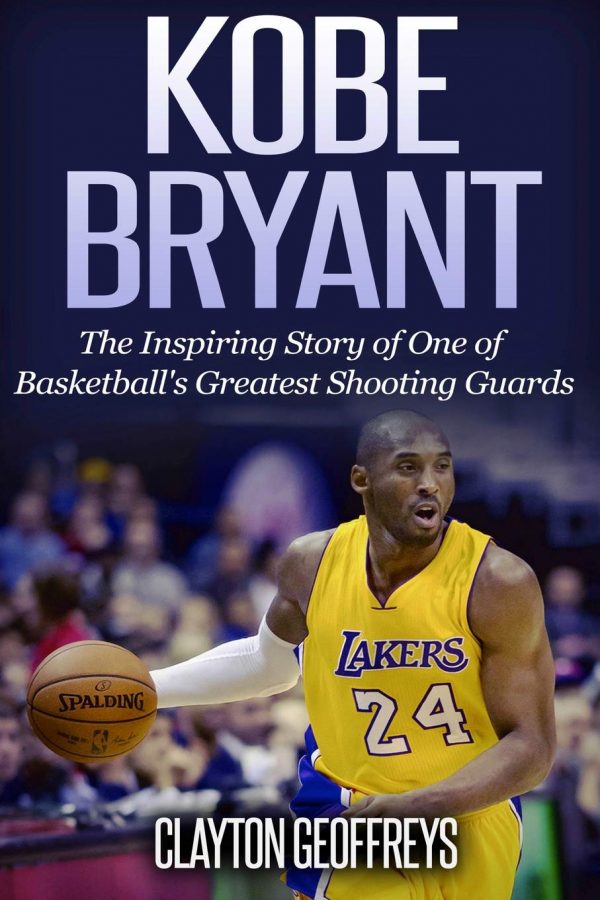Book Review: “Kobe Bryant”
Merriam-Webster defines ‘biography’ as “a usually written history of a person’s life.” Its sole purpose is to provide information, to encourage the reader to admire and reflect on the certain figure’s legacy. And Kobe Bryant is certainly a figure worthy of admiration and reflection. Written by well-known sports connoisseur Clayton Geoffreys, Bryant’s biography Kobe Bryant: The Inspiring Story of one of Basketball’s Greatest Shooting Guards, falls short on many levels of encapsulating the on-and-off-the-court legacy of Kobe Bryant.
From his historic 81-point performance at the peak of his prime in 2006 to his 60-point encore in 2016, Kobe cemented his legacy in Los Angeles, playing for the Lakers for the entirety of his 20-year career. Kobe is remembered for being a player with a tremendous work ethic and someone who always wanted to surpass others. It was these qualities that earned him the nickname “Black Mamba” early in his career.
After Bryant’s death in a Calabasas helicopter crash earlier this year, the world mourned. Players, coaches and celebrities alike used their platforms to express their thoughts and prayers to the Bryant family and the Lakers organization. I was surprised and deeply saddened to hear of Kobe’s death. I grew up watching basketball, and I admired his skills and work ethic throughout my childhood. Naturally, when it came time to pick a summer reading book in May, I chose to read Kobe Bryant’s biography.
The first red flag when I received my book was its title. The book was entitled Kobe Bryant, which was so meaningless, to me, it seemed disrespectful of the Mamba’s legacy. From the first chapter, Geoffreys’ biography is filled with grammatical and factual errors, wordiness, and redundancies that detract from the overall meaning of the book. Such unnecessary phrases as “nice little,” “on top of that,” and the use of “needless to say” after “thus” create wordiness that makes what could be a page-turner nearly unbearable to read.
There are several instances where Geoffreys subtly inserts his own opinion into the biography. Geoffreys implements the public’s view of high school Kobe as a ‘young Grant Hill,’ then compares a young Kobe to retired Kobe, stating that he has developed to resemble Michael Jordan “more than any other legend.”
On June 26, 1996, Kobe Bryant became the fifth high schooler to take the leap of faith from high school basketball to the NBA, the youngest active player in NBA history at 17. Kobe’s age at the time of his induction was an obvious career-threatening obstacle. Bryant excelled at Lower Merion High in Pennsylvania, making plays out of his teammates’ league by his upperclassman years, but would he succeed at the professional level? Would he take the reins from a waning Michael Jordan, or would he be just another round one bust, disappearing into the archives of basketball history? Most would agree he did the former, however that is difficult to discern.
Many future NBA hall-of-famers, including Bryant and current Lakers star forward LeBron James, are often compared to Jordan when debating the greatest player of all time. This is an extremely controversial topic among NBA fans, and it is difficult to insert a controversial topic in any book without inserting bias. The book should be one dedicated to the life and legacy of Kobe Bryant, not the GOAT debate.
Biographies should explain what the public thought, not what you think, of a certain historical figure, and why he or she should be remembered. The insertion of a controversial topic only detracts from the purpose of a biography. Geoffreys begins his point perfectly, then ruins it through bias.
Geoffreys makes a similar mistake when reflecting on Kobe’s academic legacy. He again begins his point well, triggering a sense of admiration and reflection in the reader by expanding Kobe’s legacy beyond the court, then inserts his personal opinion by stating that Kobe’s 1080 SAT score meant that “he could go to any college he pleased.”
In terms of basketball, it is common knowledge that Kobe could have gone to any college he wanted to. If this is the point Geoffreys is trying to make, Kobe’s SAT score is no more relevant than the 2012 Charlotte Bobcats.
Even so, the broadness of Geoffreys’ statement gives it inaccuracies that, again, detract from the purpose of a biography and Kobe’s legacy. Geoffreys is not taking into account the nuances of college admissions and scholarship offerings implied by the mention of Kobe’s SAT score. This is necessary if Geoffreys wants to expand Kobe’s legacy beyond the court in this way.
Geoffreys’ subtle flaws in the beginning shift the book away from being about Kobe and toward a summary of his career. The rest of the book is essentially filled with statistics that seem to back up Geoffreys’ opinions.
My eyelids became heavier with each passing chapter as I read summary after summary of Kobe’s most notable performances and the statistics that came with them. Not much of the biography is dedicated to Kobe’s legacy outside of the game.
Bryant was also an entrepreneur, co-founding venture capital firm Bryant Stibel with Web.com founder Jeff Stibel in 2013, shortly before his retirement. He also partnered with Nike and the Los Angeles Boys and Girls Club to launch the Mamba League, a youth basketball league headquartered at the Mamba Sports Academy. In this initiative, Bryant gave hundreds of kids free access to basketball training.
In essence, Kobe Bryant was an ambitious leader inside and outside of professional basketball, and many were touched by his death. When people see a biography about Kobe, they expect an amazing and impactful book that explains his legacy on the game of basketball and beyond, deceased with no legacy left to create or living with more path to pave. This book was not it. Geoffreys’ book, merely honing in on Kobe’s basketball career and statistics, lacks mass appeal, misleading the public to believe Kobe’s legacy is limited to the court.



